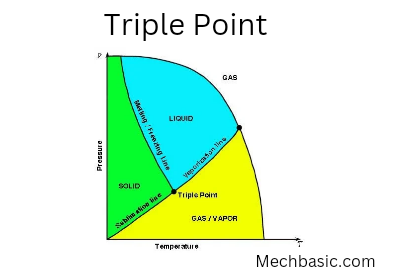Contents:
- Triple point – Definition.
- key features.
- Example for Triple point (water).
- Importance of triple point.
- Triple point in phases diagram.
- Conclusion.
Triple point-Definition:
In thermodynamics, the triple point is the unique combination of temperature and pressure at which all three phases of a substance—solid, liquid, and gas—can coexist in equilibrium. This means that, at the triple point, the substance exists simultaneously in all three phases, with each phase in equilibrium with the others.
This triple point can be explained easily by using the diagram below:

Key Features of the Triple Point:
- Equilibrium Condition:
- At the triple point, the substance is in thermodynamic equilibrium, meaning that the rates of phase transitions (e.g., melting, freezing, boiling, condensation, sublimation) are balanced. The substance remains in all three phases at the same time without any net change.
- Temperature and Pressure:
- The triple point is defined by a specific temperature and pressure. For every substance, the triple point occurs at a unique temperature and pressure that are constant for that substance.
- Phase Coexistence:
- All three phases of the substance—solid, liquid, and gas—are present at the same time. For example, in the case of water, at the triple point, ice (solid), liquid water, and water vapor (gas) coexist in a stable equilibrium.
Example: Water’s Triple Point
For water, the triple point occurs at:
- Temperature: 0.01°C (273.16 K)
- Pressure: 611.657 pascals (0.00604 atm)
At these exact conditions, water will exist simultaneously as ice, liquid water, and water vapor. If the temperature or pressure is altered even slightly, one of the phases will become unstable, and only two phases will coexist (e.g., solid-liquid, liquid-gas, etc.).
Every substance has its own unique triple point. For example:
Carbon dioxide: The triple point of CO₂ occurs at about 5.1 atm pressure and -56.6°C (216.6 K).
Helium: The triple point of helium is at a temperature of 0.29 K and a pressure of 0.29 atm.
Importance of the Triple Point:
- Standard Reference:
- The triple point is used as a standard reference in thermodynamics and the definition of temperature scales. For example, the Kelvin scale is defined based on the triple point of water. The Kelvin scale sets the absolute zero point (0 K) and uses the triple point of water (273.16 K) as a reference for the thermodynamic temperature.
- Phase Diagrams:
- The triple point plays a crucial role in phase diagrams, which represent the phase behavior of a substance at different pressures and temperatures. The triple point marks the intersection where the solid, liquid, and gas phases meet.
- Fundamental Thermodynamic Concept:
- The concept of the triple point helps understand the nature of phase transitions. It illustrates how a substance can undergo phase changes when temperature and pressure conditions are altered.
Triple Point in a Phase Diagram
In a phase diagram (temperature vs. pressure plot), the triple point is represented by a single point where all three phase boundaries (solid-liquid, liquid-gas, and solid-gas) intersect. It marks the conditions under which a substance can exist in all three phases simultaneously.
Conclusion
The triple point is a critical thermodynamic concept that represents the unique set of temperature and pressure conditions where a substance can exist in all three phases—solid, liquid, and gas—simultaneously.
It is used as a reference in defining temperature scales and plays a significant role in understanding phase transitions and the behavior of materials under varying conditions.
Also Read :
- Phase Diagram.
- pvt Relations.
- Phase of matter.
